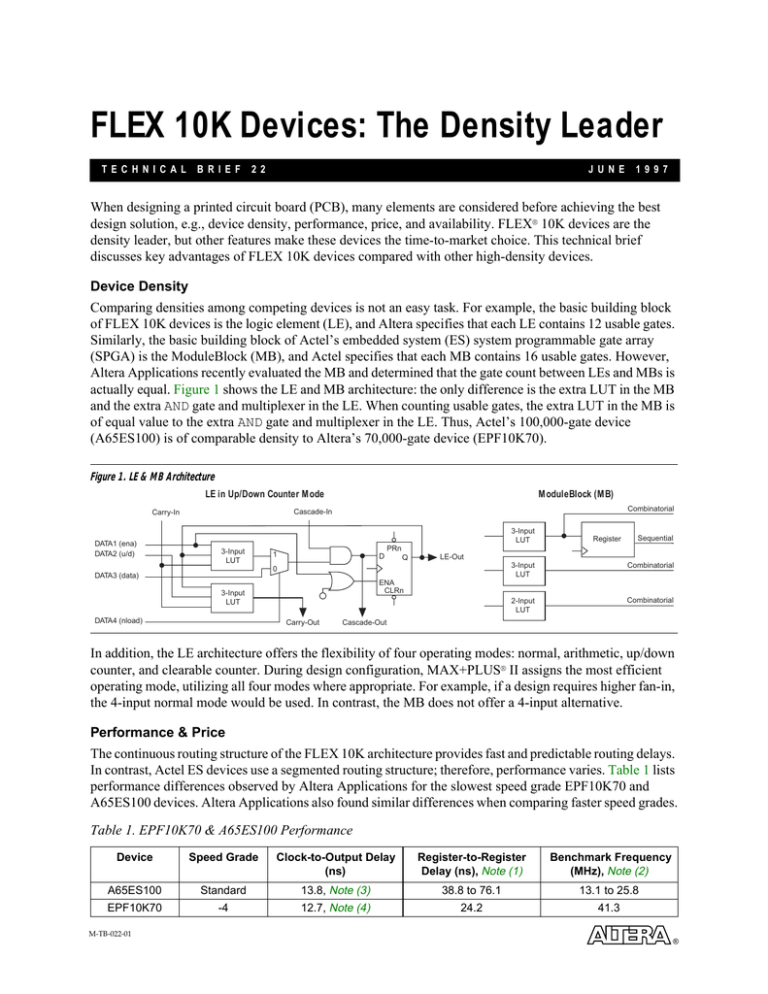
FLEX 10K Devices: The Density Leader
T E C H N I C A L
B R I E F
2 2
J U N E
1 9 9 7
When designing a printed circuit board (PCB), many elements are considered before achieving the best
design solution, e.g., device density, performance, price, and availability. FLEX® 10K devices are the
density leader, but other features make these devices the time-to-market choice. This technical brief
discusses key advantages of FLEX 10K devices compared with other high-density devices.
Device Density
Comparing densities among competing devices is not an easy task. For example, the basic building block
of FLEX 10K devices is the logic element (LE), and Altera specifies that each LE contains 12 usable gates.
Similarly, the basic building block of Actel’s embedded system (ES) system programmable gate array
(SPGA) is the ModuleBlock (MB), and Actel specifies that each MB contains 16 usable gates. However,
Altera Applications recently evaluated the MB and determined that the gate count between LEs and MBs is
actually equal. Figure 1 shows the LE and MB architecture: the only difference is the extra LUT in the MB
and the extra AND gate and multiplexer in the LE. When counting usable gates, the extra LUT in the MB is
of equal value to the extra AND gate and multiplexer in the LE. Thus, Actel’s 100,000-gate device
(A65ES100) is of comparable density to Altera’s 70,000-gate device (EPF10K70).
Figure 1. LE & MB Architecture
LE in Up/Down Counter Mode
DATA1 (ena)
DATA2 (u/d)
ModuleBlock (MB)
Combinatorial
Cascade-In
Carry-In
3-Input
LUT
3-Input
LUT
1
D
Q
3-Input
LUT
Combinatorial
2-Input
LUT
Combinatorial
ENA
CLRn
3-Input
LUT
DATA4 (nload)
Sequential
LE-Out
0
DATA3 (data)
Register
PRn
Carry-Out
Cascade-Out
In addition, the LE architecture offers the flexibility of four operating modes: normal, arithmetic, up/down
counter, and clearable counter. During design configuration, MAX+PLUS® II assigns the most efficient
operating mode, utilizing all four modes where appropriate. For example, if a design requires higher fan-in,
the 4-input normal mode would be used. In contrast, the MB does not offer a 4-input alternative.
Performance & Price
The continuous routing structure of the FLEX 10K architecture provides fast and predictable routing delays.
In contrast, Actel ES devices use a segmented routing structure; therefore, performance varies. Table 1 lists
performance differences observed by Altera Applications for the slowest speed grade EPF10K70 and
A65ES100 devices. Altera Applications also found similar differences when comparing faster speed grades.
Table 1. EPF10K70 & A65ES100 Performance
Device
Speed Grade
Clock-to-Output Delay
(ns)
Register-to-Register
Delay (ns), Note (1)
Benchmark Frequency
(MHz), Note (2)
A65ES100
Standard
13.8, Note (3)
38.8 to 76.1
13.1 to 25.8
EPF10K70
-4
12.7, Note (4)
24.2
41.3
M-TB-022-01
®
ALTERA MEGAFUNCTION PARTNERS PROGRAM
Notes to table:
(1)
(2)
(3)
(4)
The register-to-register delay was obtained from the Actel Reprogrammable SPGAs Preliminary Advance Information, the Altera 1996 Data
Book, and the MAX+PLUS II development system.
The benchmark frequency is the inverse of the register-to-register delay and represents the system clock frequency for an average
application. The register-to-register path contains a register driving another register through three combinatorial LEs and some routing.
In some applications, clock frequencies can reach much higher values.
The Actel Reprogrammable SPGAs Preliminary Advance Information states that the A65ES100 -1 speed grade has a clock-to-output delay of
12 ns. Therefore, because Actel states that the A65ES100 -1 speed grade is 15% faster than the Standard speed grade, the clock-to-output
delay is approximately (12 ns) X (1.15) = 13.8 ns.
Source: Altera 1996 Data Book
Table 2 shows density, price, and routing differences for comparable FLEX 10K and ES SPGA devices.
Table 2. EPF10K70 & A65ES100 Device Density, Price, and Routing
Device
Speed Grade
Density, Note (1)
Price
Routing
A65ES100
Standard
73,000
$348, Note (2)
Segmented
EPF10K70
-4
72,000
$175, Note (3)
Continuous
Notes:
(1)
(2)
(3)
Based on 12 usable gates per MB/LE.
Projected production pricing from the following Actel press release, Actel Announces the Industry’s First Family of System Programmable Gate
Arrays; ES "System on a Chip" Family Offers Up to 400,000 Programmable Gates; Includes Embedded ASIC Cores, October 21, 1996.
Production pricing (1-5K units) for third quarter 1997.
Availability
The most important time-to-market issue is availability. The FLEX 10K device family offers immediate
availability with densities ranging from 10,000 to 130,000 gates. As of this printing, Actel’s high density
device offering is not yet available. Table 3 lists FLEX 10K and ES SPGA device availability.
Table 3. FLEX 10K & ES SPGA Device Availability
FLEX 10K Device
Availability
ES SPGA Device
Claimed Availability
Note (1)
EPF10K70
Now
A65ES100
First half of 1997
EPF10K100
Now
A65ES150
Not disclosed
EPF10K130V
Now
A65ES200
Not disclosed
Note:
(1)
Source: Actel press release, Actel Announces the Industry’s First Family of System Programmable Gate Arrays; ES "System on a Chip" Family
Offers Up to 400,000 Programmable Gates; Includes Embedded ASIC Cores, October 21, 1996.
The documents listed below provide more detailed information. The part numbers are in parentheses.
■
■
Gate Counting Methodology for Altera’s FLEX 10K Family of Embedded Programmable Logic
(M-WP-GAEPLF-01)
FLEX 10K Embedded Programmable Logic Family Data Sheet (A-DS-F10K-02), available in the
Altera 1996 Data Book
You can request documents from:
■
■
■
Altera Literature Services at (888) 3-ALTERA
World-wide web at http://www.altera.com
Your local Altera sales representative
Copyright 1997 Altera Corporation. Altera, MAX, MAX+PLUS, MAX+PLUS II, FLEX, FLEX 10K, EPF10K70, EPF10K100, and
EPF10K130V are trademarks and/or service marks of Altera Corporation in the United States and/or other countries. Other brands or
products are trademarks of their respective holders. All rights reserved.
®


